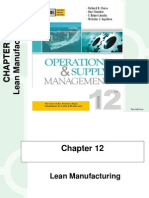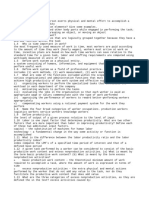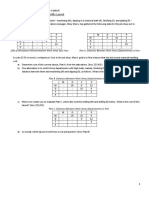Tutorial 2 - Solution
Uploaded by
Ruby LimTutorial 2 - Solution
Uploaded by
Ruby LimBEKC 4883
ADVANCE MANUFACTURING SYSTEM (2010/2011)
NAME : ANUAR BIN MOHAMED KASSIM COURSE : 4BEKM
TUTORIAL 2 (SCHEME)
1.
What is manufacturing?
Answer: Two definitions are given in the text, one technological and the other economic. The technological definition is the following: Manufacturing is the application of physical and chemical processes to alter the geometry, properties, and/or appearance of a given starting material to make parts or products; manufacturing also includes the joining of multiple parts to make assembled products. The economic definition is the following: Manufacturing is the transformation of materials into items of greater value by means of one or more processing and/or assembly operations.
2.
What is the difference between a processing operation and an assembly operation?
Answer: A processing operation transforms a work material from one state of completion to a more advanced state that is closer to the final desired part or product. It adds value by changing the geometry, properties, or appearance of the starting material. An assembly operation joins two or more components to create a new entity, called an assembly, subassembly, or some other term that refers to the joining process.
3.
What is the difference between hard product variety and soft product variety?
Answer: Hard product variety is when the products differ substantially. In an assembled product, hard variety is characterized by a low proportion of common parts among the products; in many cases, there are no common parts. Soft product variety is when there are only small differences between products. There is a high proportion of common parts among assembled products whose variety is soft.
4.
What is lean production?
Answer: The definition given in the text is the following: Lean production means operating the factory with the minimum possible resources and yet maximizing the amount of work that is accomplished with these resources. Lean production also implies completing the products in the minimum possible time and achieving a very high level of quality, so that the customer is completely satisfied. In short, lean production means doing more with less, and doing it better.
5.
In lean production, what is just-in-time delivery of parts?
Answer: As defined in the text, just-in-time delivery of parts refers to the manner in which parts are moved through the production system when a sequence of manufacturing operations is required to make them. In the ideal just-in-time system, each part is delivered to the downstream workstation immediately before that part is needed at the station.
6.
In lean production, what does continuous improvement mean, and how is it usually accomplished?
Answer: Continuous improvement involves an unending search for ways to make improvements in products and manufacturing operations. It is usually accomplished by worker teams who cooperate to develop solutions to production and quality problems.
7.
The ABC Company is planning a new product line and will build a new plant to manufacture the parts for a new product line. The product line will include 50 different models. Annual production of each model is expected to be 1000 units. Each product will be assembled of 400 components. All processing of parts will be accomplished in one factory. There are an average of 6 processing steps required to produce each component, and each processing step takes 1.0 minute (includes an allowance for setup time and part handling). All processing operations are performed at workstations, each of which includes a production machine and a human worker. If each workstation requires a floor space of 250 ft2, and the factory operates one shift (2000 hr/yr), determine (a) how many production operations, (b) how much floorspace, and (c) how many workers will be required in the plant.
Solution: This problem neglects the effect of assembly time. (a) nof = PQnpno = 50(1000)(400)(6) = 120,000,000 operations in the factory per year. (c) Total operation time = (120 x 106 ops)(1min./(60 min./hr)) = 2,000,000 hr/yr. At 2000 hours/yr per worker, w =
2,000,000hr / yr = 1000 workers. 2000hr / wor ker
(b) Number of workstations n = w = 1000. Total floorspace = (1000 stations)(250 ft2/station) = 250,000 ft2
8.
The XYZ Company is planning to introduce a new product line and will build a new factory to produce the parts and assembly the final products for the product line. The new product line will include 100 different models. Annual production of each model is expected to be 1000 units. Each product will be assembled of 600 components. All processing of parts and assembly of products will be accomplished in one factory. There are an average of 10 processing steps required to produce each component, and each processing step takes 30 sec. (includes an allowance for setup time and part handling). Each final unit of product takes 3.0 hours to assemble. All processing operations are performed at work cells that each includes a production machine and a human worker. Products are assembled on single workstations consisting of two workers each. If each work cell and each workstation require 200 ft2, and the factory operates one shift (2000 hr/yr), determine: (a) how many production operations, (b) how much floorspace, and (c) how many workers will be required in the plant.
Solution: (a) Qf = PQ = 100(1000) = 100,000 products/yr Number of final assembly operations = 100,000 asby ops/yr Number of processing operations nof = PQnpno = 100(1000)(600)(10) = 600,000,000 proc ops/yr (c) Total processing operation time = (600 x 106 ops)(0.5 min./(60 min./hr)) = 5,000,000 hr/yr. Total assembly operation time = (100 x 103 asby ops)(3 hr/product) = 300,000 hr/yr Total processing and assembly time = 5,300,000 hr/yr
At 2000 hours/yr per worker, w =
5,300,000hr / yr = 2650 workers. 2000hr / wor ker
(b) With 1 worker per workstation for processing operations, n = w = 2500 = 2500 workstations. With 2 workers per stations for assembly, n = w/2 = 150/2 = 75 workstations. Total floor space A = (2575 stations)(200 ft2/station) = 515,000 ft2
You might also like
- Automation Production Systems and Computer Integrated Manufacturing 4th Edition Groover Solution Manual100% (44)Automation Production Systems and Computer Integrated Manufacturing 4th Edition Groover Solution Manual6 pages
- Lean Manufacturing: Operations ManagementNo ratings yetLean Manufacturing: Operations Management37 pages
- Manufacturing Operations: Review QuestionsNo ratings yetManufacturing Operations: Review Questions3 pages
- Introduction To Process Industry By: Engr. Dr. Syed Amjad AhmadNo ratings yetIntroduction To Process Industry By: Engr. Dr. Syed Amjad Ahmad30 pages
- Product/Production Relationships: Solution: This Problem Neglects The Effect of Assembly TimeNo ratings yetProduct/Production Relationships: Solution: This Problem Neglects The Effect of Assembly Time2 pages
- ProductionAndOperationsManagement MB014 Question100% (1)ProductionAndOperationsManagement MB014 Question29 pages
- P 6 + 4 + 8 18 Different Models.: 5 300 000 2000,, / / Ker HR Yr HR WorNo ratings yetP 6 + 4 + 8 18 Different Models.: 5 300 000 2000,, / / Ker HR Yr HR Wor3 pages
- ProductionPlanningAndControl MB065 QuestionNo ratings yetProductionPlanningAndControl MB065 Question23 pages
- Manufacturing System Study Guide - Week 2No ratings yetManufacturing System Study Guide - Week 24 pages
- Manufacturing Automation Complex Engineering Problem: Sir Saad FarooqNo ratings yetManufacturing Automation Complex Engineering Problem: Sir Saad Farooq18 pages
- Computer Science Textbook Solutions - 7No ratings yetComputer Science Textbook Solutions - 730 pages
- OPM101Chapter8.1 - Supply Capacity and FaciltyNo ratings yetOPM101Chapter8.1 - Supply Capacity and Facilty74 pages
- Operations and Supply Chain Management The Core 3rd Edition Jacobs Solutions Manual DownloadNo ratings yetOperations and Supply Chain Management The Core 3rd Edition Jacobs Solutions Manual Download14 pages
- TIE6111201301Design Analysis and Control of Manufacturing SystemsNo ratings yetTIE6111201301Design Analysis and Control of Manufacturing Systems8 pages
- Flexsim Tutorial 8: 1. Objective of ProblemNo ratings yetFlexsim Tutorial 8: 1. Objective of Problem5 pages
- ProductionPlanningAndControl MB065 QuestionNo ratings yetProductionPlanningAndControl MB065 Question22 pages
- Line Balancing: Output (Production) RateNo ratings yetLine Balancing: Output (Production) Rate14 pages
- Experiment No: 3: AIM: To Study About Flexible Manufacturing SystemNo ratings yetExperiment No: 3: AIM: To Study About Flexible Manufacturing System17 pages
- Creating a One-Piece Flow and Production Cell: Just-in-time Production with Toyota’s Single Piece FlowFrom EverandCreating a One-Piece Flow and Production Cell: Just-in-time Production with Toyota’s Single Piece Flow4/5 (1)
- Takt Time: A Guide to the Very Basic Lean CalculationFrom EverandTakt Time: A Guide to the Very Basic Lean Calculation5/5 (2)
- Cochin University of Science and TechnologyNo ratings yetCochin University of Science and Technology2 pages
- Product Lifecycle Management: Dr. Michael Grieves Co-Director U of M PLM Development Consortium WWW - Plmdc.engin - Umich.eduNo ratings yetProduct Lifecycle Management: Dr. Michael Grieves Co-Director U of M PLM Development Consortium WWW - Plmdc.engin - Umich.edu24 pages
- Ohio Center of Excellence in Knowledge-Enabled Computing - ProposalNo ratings yetOhio Center of Excellence in Knowledge-Enabled Computing - Proposal50 pages
- Call For Papers, Journal: Mathematics (MDPI) - Special Issue: "Markov-Chain Modelling and Applications". Deadline: 28 February, 2022No ratings yetCall For Papers, Journal: Mathematics (MDPI) - Special Issue: "Markov-Chain Modelling and Applications". Deadline: 28 February, 20222 pages
- Sri Vidya College of Engineering and Technology Unit I Course Material: Lecture NotesNo ratings yetSri Vidya College of Engineering and Technology Unit I Course Material: Lecture Notes50 pages
- اﻹبتكار واﻹبداع في قطاع المقاولات - دراسة التجربة الوطنية و تجارب دولية رائدةNo ratings yetاﻹبتكار واﻹبداع في قطاع المقاولات - دراسة التجربة الوطنية و تجارب دولية رائدة17 pages
- A Detailed Lesson Plan in Media and Information Technology89% (9)A Detailed Lesson Plan in Media and Information Technology4 pages
- Aegis Data Science Congress 2017 BrochureNo ratings yetAegis Data Science Congress 2017 Brochure2 pages
- The Attraction of BIM Solutions Using Revit100% (1)The Attraction of BIM Solutions Using Revit9 pages
- Hall Ticket: TCS Off Campus - Batch of 2018: VenueNo ratings yetHall Ticket: TCS Off Campus - Batch of 2018: Venue2 pages
- CE Thesis Format (Based On RDCO Format)No ratings yetCE Thesis Format (Based On RDCO Format)19 pages
- Design For Manufacturing and Assembly of A Connecting Rod 1362031980No ratings yetDesign For Manufacturing and Assembly of A Connecting Rod 13620319807 pages
- Statement of Purpose Masters of Science in Information SystemsNo ratings yetStatement of Purpose Masters of Science in Information Systems1 page
- 2008 - Government College of Engineering, AurangabadNo ratings yet2008 - Government College of Engineering, Aurangabad7 pages

























































































